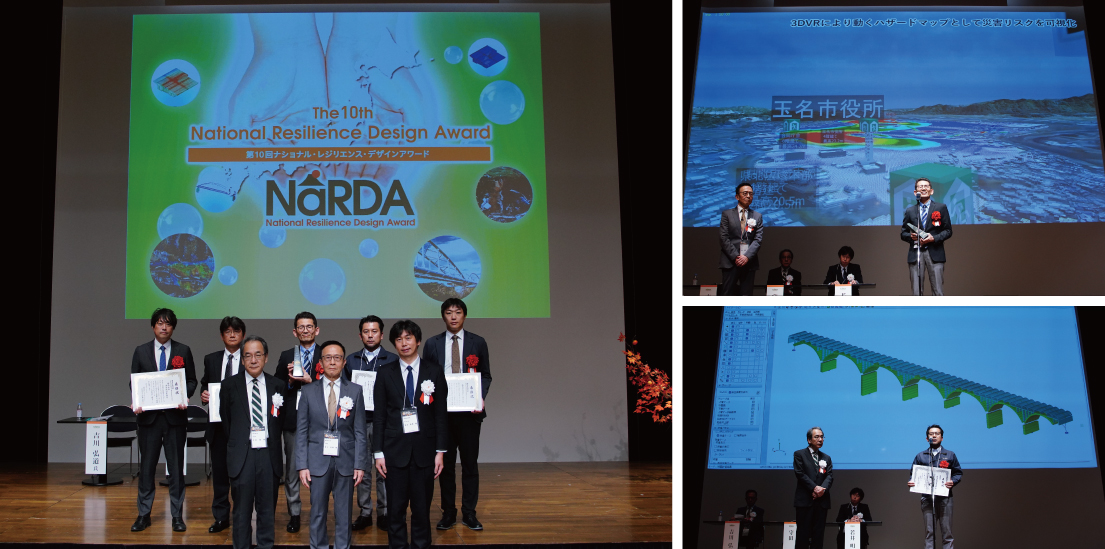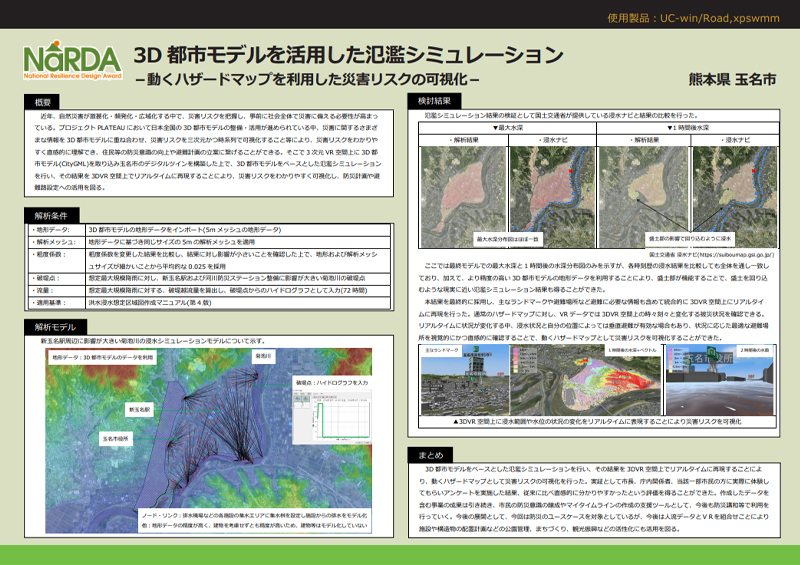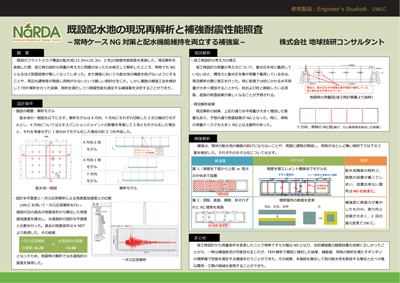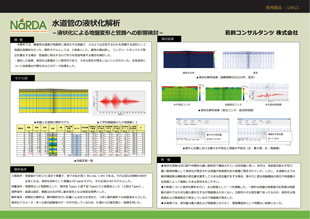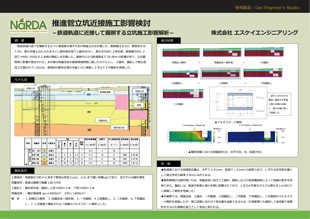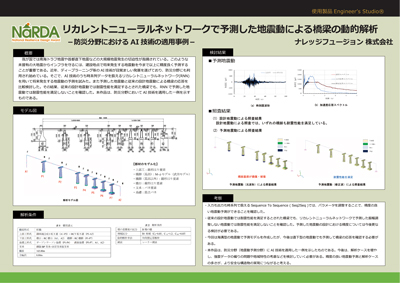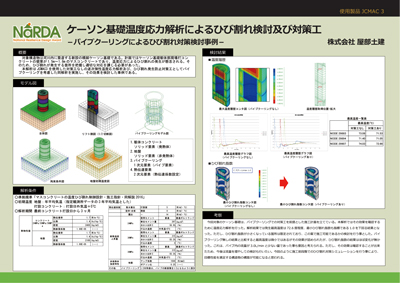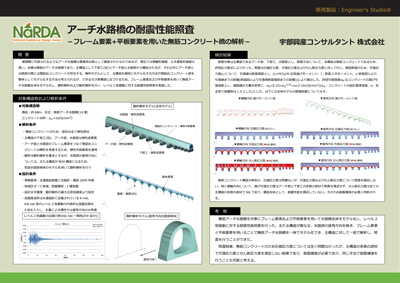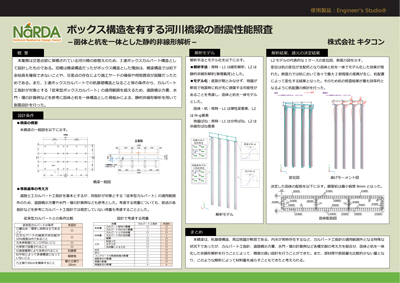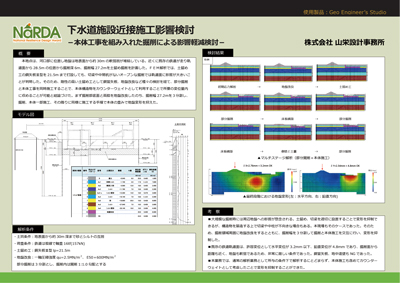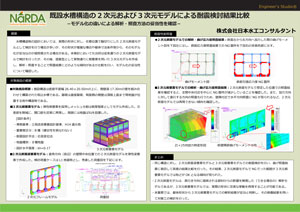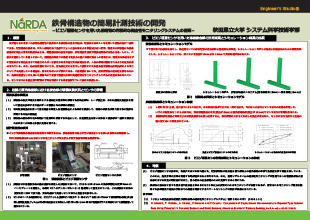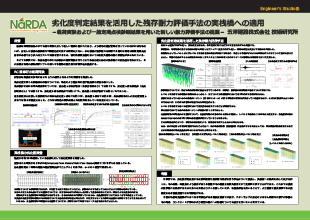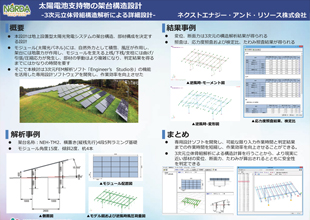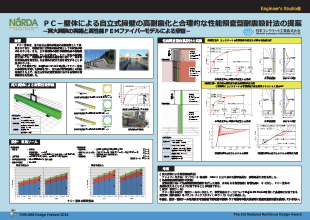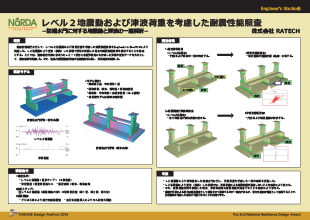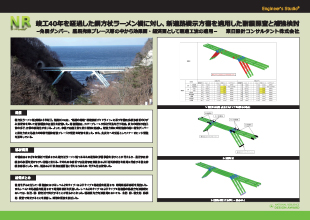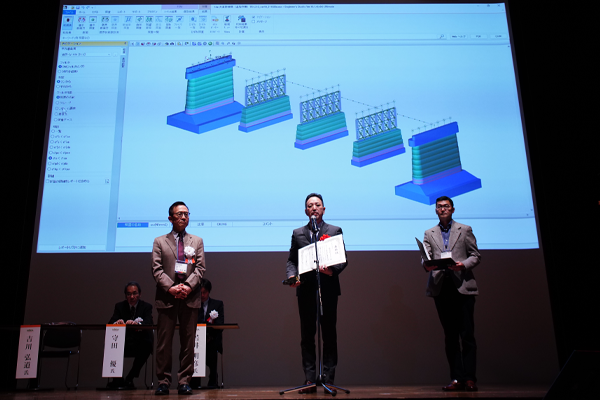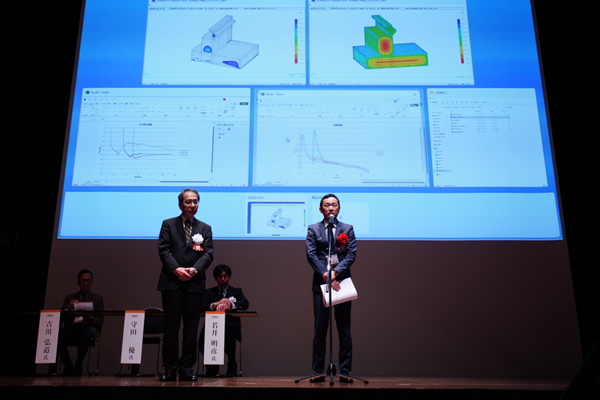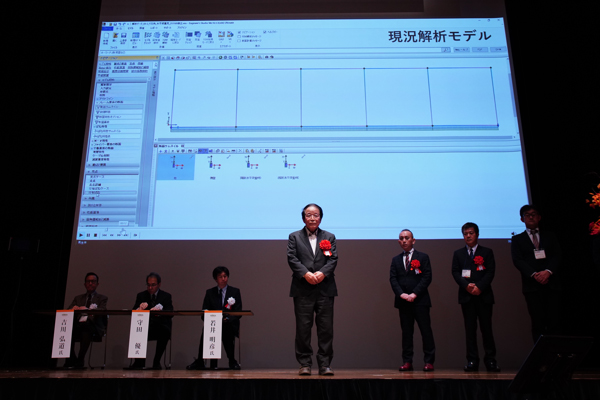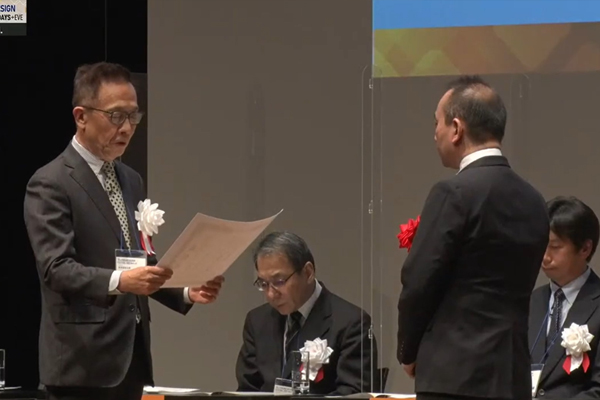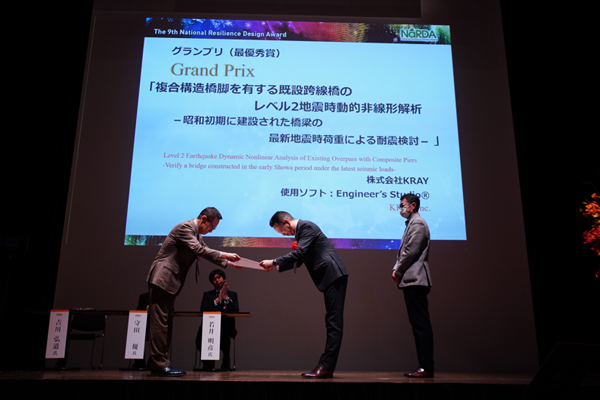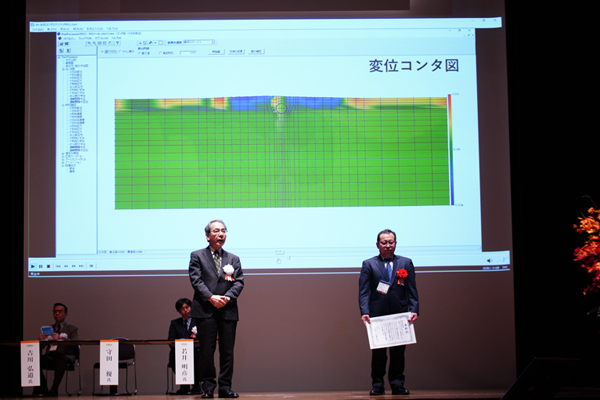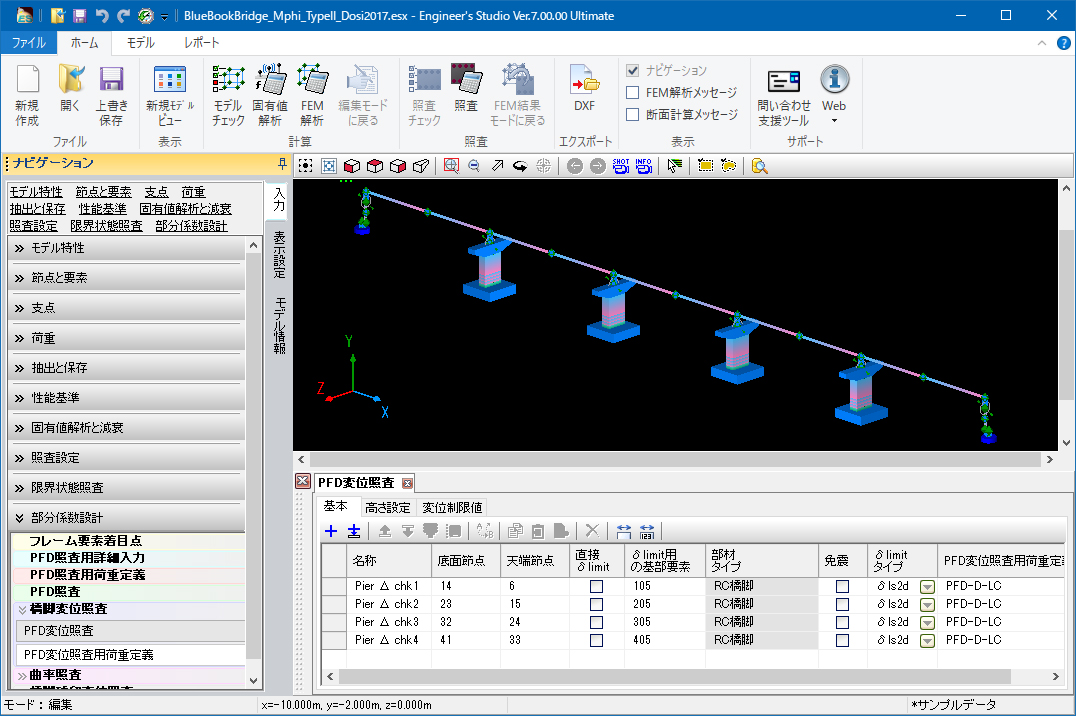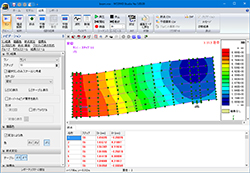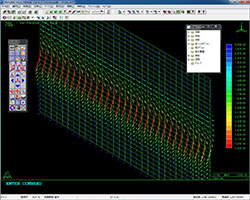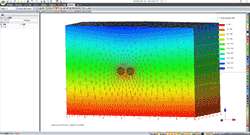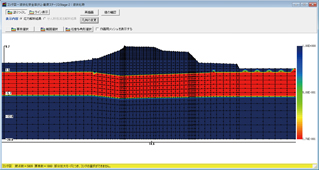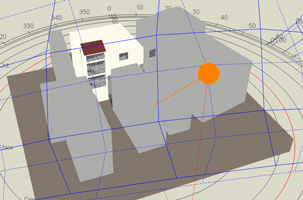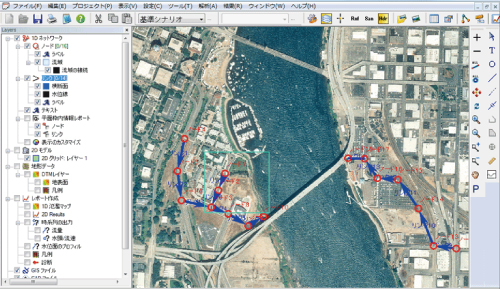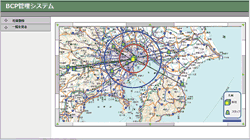Results
After careful consideration by juries, Grand Prix, 2nd Prize, and 3 Honorable Judge Award have been selected. On November 10th 2023, the Awards Ceremony was held at Shinagawa Intercity Hall.
▲Awards Ceremony (November 10th 2023, at Shinagawa Intercity Hall)
-
Grand Prix (Highest Award)
Tamana City, Kumamoto Prefecture
Flood simulation using 3D city model - Visualize disaster risks using moving hazard maps -
-
Program Used: UC-win/Road, xpswmm
In recent years, as natural disasters have become more severe, frequent, and widespread, there has been a growing need for society as a whole to understand disaster risk and prepare for disasters in advance. As more and more 3D city models across Japan are developed and used in the Project PLATEAU, various disaster-related information is superimposed on the 3D city models to visualize disaster risks in 3D and in chronological order. This makes it easy to understand in an intuitive way, which can lead to improved disaster prevention awareness among residents and the formulation of evacuation plans. Therefore, a digital twin of Tamana City was created by incorporating a 3D city model (CityGML) into the 3D VR space, and a flood simulation was performed based on the 3D city model. The results were reproduced in real time in the 3D VR space, showing disaster risks in an easy-to-understand way. It is also planned to use them for disaster prevention planning and evacuation route determination.
-
2nd Prize (Excellence Award)
KAJIMA CORPORATION
New Meishin Expressway Tenjingawa Bridge Design
- To ensure the structural integrity of RC 7-span continuous double-layer arch bridge -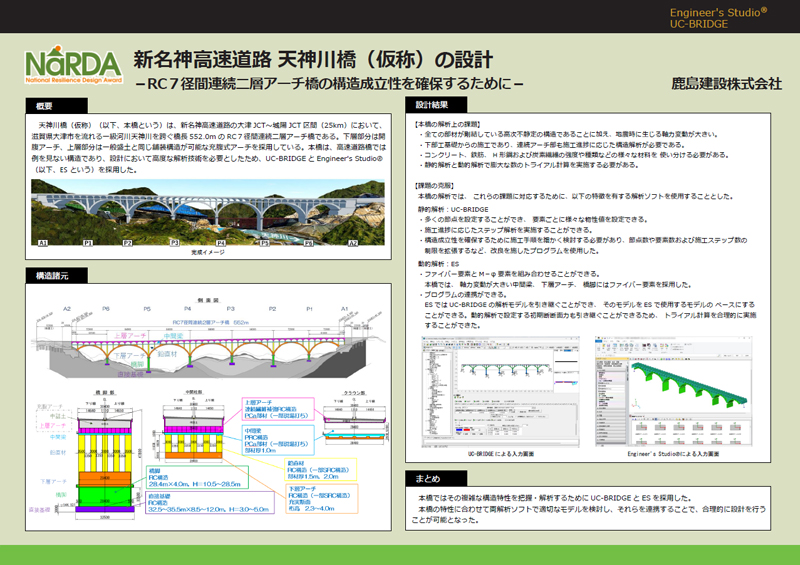
 Program Used:
Program Used:
Engineer's Studio®,
UC-BRIDGE・3DCAD (Partial Factor Method)Tenjingawa Bridge (tentative name) is a 7-span continuous double-layer arch RC bridge with a length of 552.0 m. It is located between the Otsu JCT and the Joyo JCT (25 km) of the Shin-Meishin Expressway at the section over the Tenjingawa River, a first-class river flowing through Otsu City, Shiga Prefecture. The lower part is an open spandrel arch, and the upper part uses a solid spandrel arch, which allows a pavement structure similar to that of ordinary embankments. Because this bridge had a structure unprecedented in highway bridges, advanced analysis techniques were required in its design, and UC-BRIDGE and Engineer's Studio® were used for the analysis.
-
Honorable Judge Award (Prof. Hiromichi Yoshikawa)
Structural Performance-based Design AwardChiyoda Engineering Consultants Co., Ltd.
Seismic reinforcement design for a four-span continuous steel truss bridge
-Parametric analysis to find the optimal reinforcement method-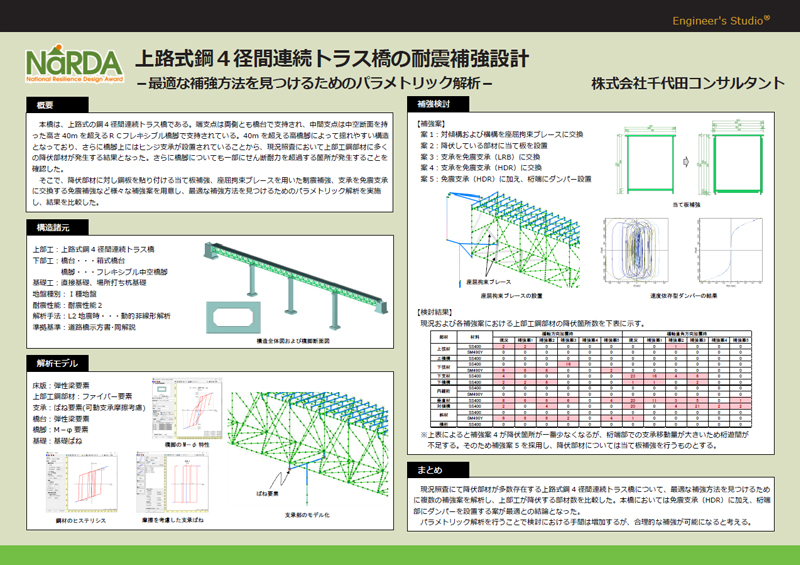
 Program Used:
Program Used:
Engineer's Studio®
This bridge is a four-span continuous steel truss bridge of the upper deck type. Both ends are supported by abutments, and the intermediate supports are RC flexible piers over 40m high with a hollow section. In addition to the fact that the structure is prone to swaying due to the high piers of over 40m, the hinge bearings installed on the piers resulted in many yielding members in the upper structural steel members during the current status review. It was also confirmed that there were parts of the bridge piers that exceeded their shear strength. Therefore, various reinforcement plans were prepared, such as plate reinforcement by attaching steel plates to yielding members, vibration control by using buckling restraint braces, and seismic isolation by replacing bearings with seismic isolation bearings. A parametric analysis was then performed and the results were compared to find the optimal reinforcement method. -
Honorable Judge Award (Prof. Masaru Morita)
Flood Inundation Management AwardMizota Design Office
Flood analysis of small rivers
- Flood risk assessment using flood simulation -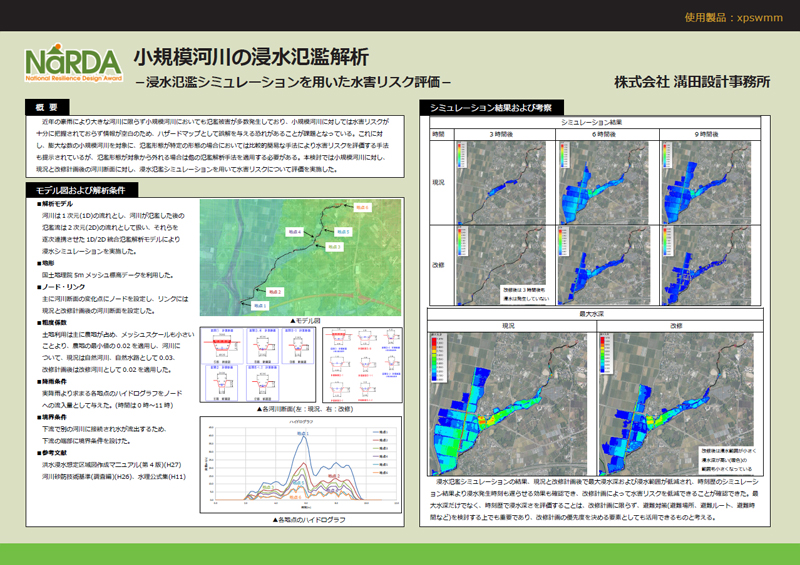
 Program Used: xpswmm
Program Used: xpswmmIn recent years, damage caused by heavy rains has occurred not only in large rivers but also in small rivers. As the flood risk for small rivers is not fully understood and its information is insufficient, there are problems to use the existing hazard map as a reliable material. On the other hand, a relatively simple method has been proposed to assess flood risk for a large number of small rivers against specific types of floods. However, if it does not cover the types of floods, we need to apply other flood analysis methods. In this study, the flood risk of small rivers was evaluated using flood simulations for the current river and the cross-section of the river after improvement.
-
Honorable Judge Award (Prof. Akihiko Wakai)
SDGs-Oriented Building Design AwardTAKENAKA CORPORATION
3-story building (S+RC structure) energy simulation
-Verify system control for energy savings-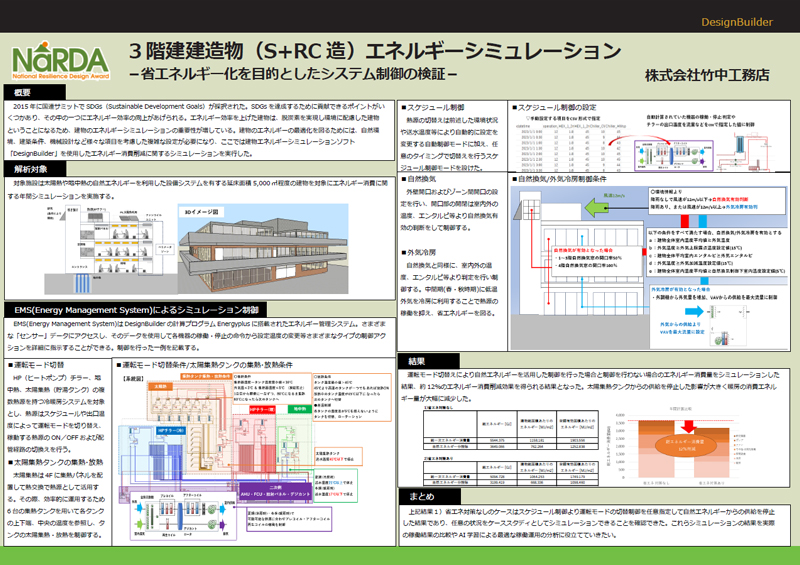
 Program Used: DesignBuilder
Program Used: DesignBuilderIn 2015, the Sustainable Development Goals (SDGs) were adopted at a United Nations summit. There are several points that can contribute to achieving the SDGs, one of which is improving energy efficiency. Energy simulation for buildings is becoming increasingly important as buildings with increased energy efficiency are considered decarbonized and green buildings. Optimizing a building's energy consumption requires complex settings that take into account a variety of factors, including the natural environment, architectural conditions, and mechanical design. In this project, the simulation of energy consumption reduction was performed using "DesignBuilder", the building energy simulation software.
-
Nomination Award
KATAHIRA & ENGINEERS INC.
Stress analysis of a widening monolithic bridge with different support conditions at the same support point
-3D FEM analysis using solid/shell elements-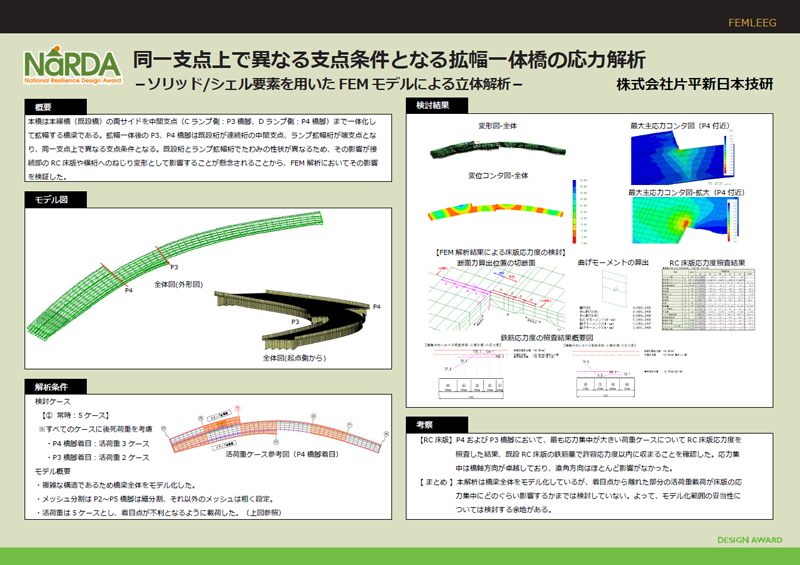
 Program Used: FEMLEEG
Program Used: FEMLEEG
This bridge will be expanded by integrating both sides of the mainline bridge (existing bridge) up to the intermediate support (C ramp side: P3 pier, D ramp side: P4 pier). For the P3 and P4 piers, after the integration, the existing girder will be the intermediate fulcrum of the continuous girder, and the ramp widening girder will be the end fulcrum, resulting in different fulcrum conditions at the same fulcrum. Since the existing girder and the ramp widening girder have different deflection properties, there is a concern that the deflection may affect the RC slab and transverse girder at the connection area as a torsional deformation. In this project, the influence was verified using FEM analysis. -
Nomination Award
NTC Consultants Inc.
Comparative verification of analysis methods for a water tank with a full opening
- Reconfirm applicability of conventional and new methods -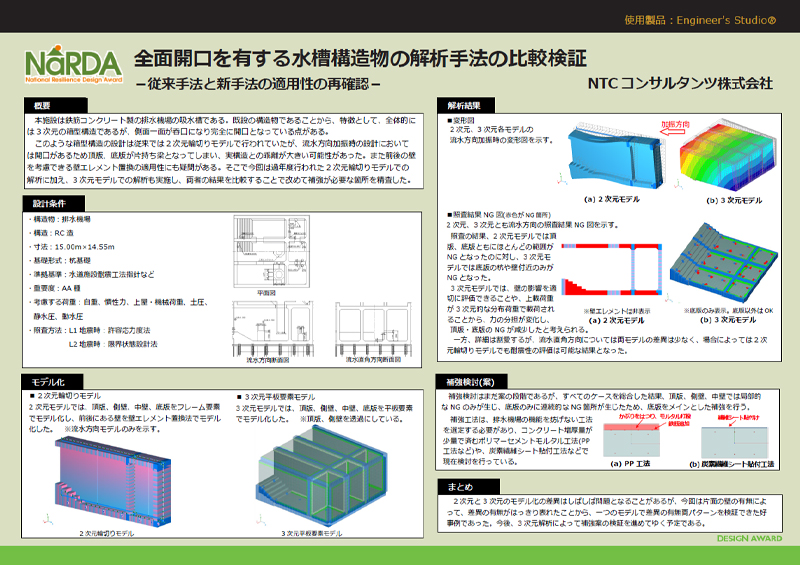
 Program Used:
Program Used:
Engineer's Studio®
This facility is an existing 3D box water absorption tank in a drainage pump station made of reinforced concrete and has a full opening on one side. Conventionally, such a box-shaped structure was designed using 2D sectional models, but when designing the excitation in the direction of the flowing water for this water tank, since the top and bottom plates were cantilevered due to the opening, there might be a large difference between the actual structure and the design using the 2D sectional models. There are also doubts about the applicability of the wall element replacement, which can take front and back walls into consideration. Therefore, in addition to the analysis conducted in previous years using 2D sectional models, another analysis was also performed using a 3D model to compare the results of both analyses and to examine areas that needed reinforcement. -
Nomination Award
Nissin Tech
Seismic reinforcement of existing steel reinforced suspension bridge
-Reinforcement of difficult structures using sophisticated analytical models-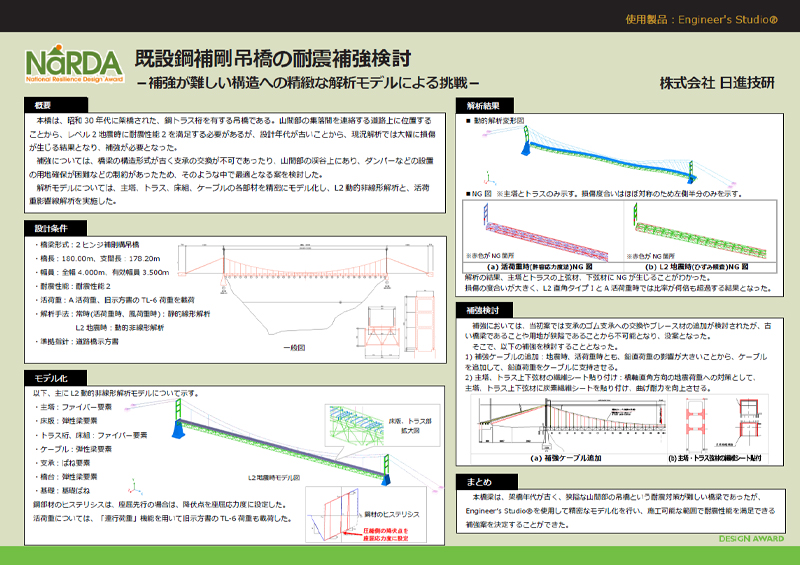
 Program Used:
Program Used:
Engineer's Studio®
This is an analysis of a steel truss suspension bridge built in the 1950s. Because it is located on a road connecting villages in a mountainous area, it is required to meet the seismic performance 2 in the event of a level 2 earthquake. However, since it was designed many years ago, an analysis of the current situation shows that it will be significantly damaged by earthquakes and needs to be reinforced. The bridge's structure was old and it would be difficult to replace bearings or install dampers, and the bridge was located in a valley in the mountains, making it difficult to secure the land. The company considered the best reinforcement option under these conditions. Each member of the main tower, truss, floor assembly, and cables were modeled precisely, and L2 dynamic nonlinear analysis and live load influence line analysis were performed. -
Nomination Award
Knowledge Fusion Co., Ltd.
Seismic reinforcement of existing agricultural irrigation facilities for level 2 earthquakes
-In response to reports of severe disasters in recent years-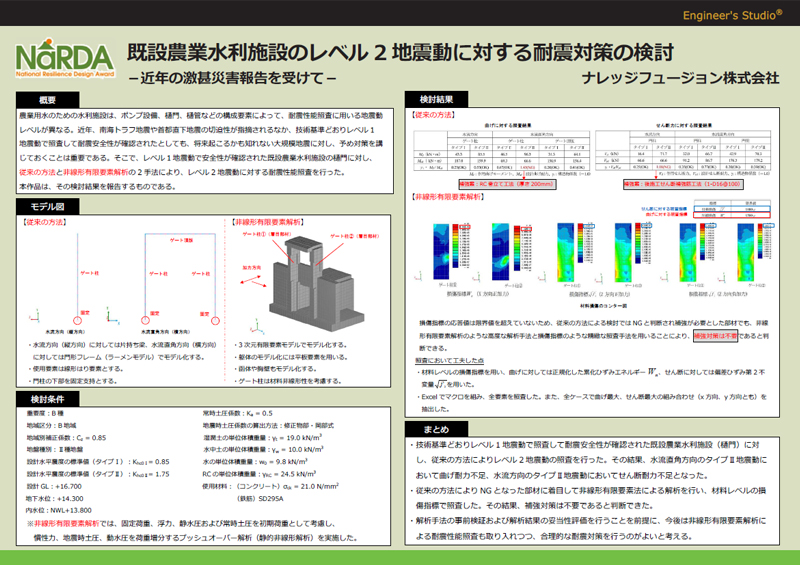
 Program Used:
Program Used:
Engineer's Studio®
The seismic motion level used to verify the seismic performance of agricultural irrigation facilities differs depending on the components such as pump equipment, sluices, and sluice pipes. In recent years, the impending possibility of the Nankai Trough Earthquake or the Metropolitan Inland Earthquake has been pointed out, and even though the seismic safety has been confirmed by verification using the Level 1 seismic motion according to technical standards, it is important to prepare in advance for large earthquakes that may occur in the future. Therefore, the company conducted a seismic performance test against the Level 2 seismic motion for the water gates of existing agricultural irrigation facilities designed using the Level 1 seismic motion, and proposed a rational seismic reinforcement plan by using effective modeling and verification methods. -
Nomination Award
Doboku Giken
Study on the impact of construction near overpass bridges
-Liner plate excavation associated with strengthening of existing bridge piers-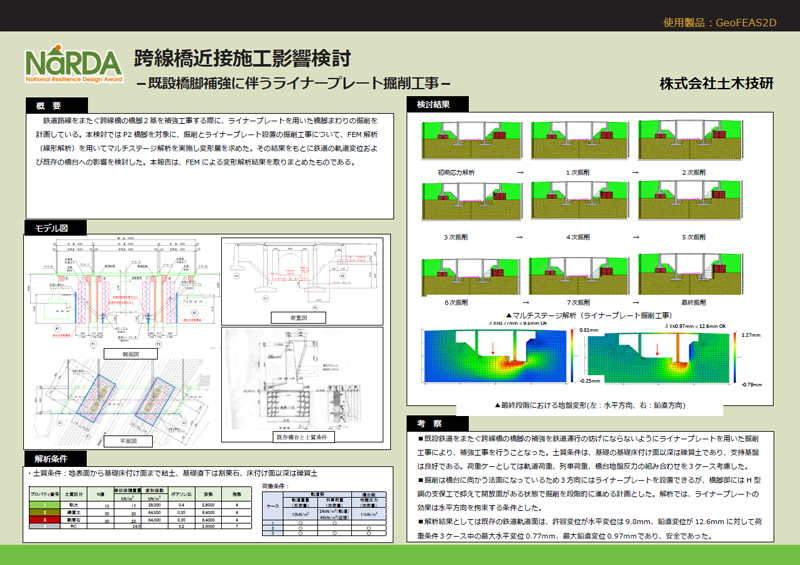
 Program Used:
Program Used:
GeoFEAS 2D
When reinforcing the two piers of the overpass bridge above railroads, it is planned to excavate around the piers using liner plates. In this study, the company conducted a multi-stage analysis using FEM analysis to determine the amount of deformation for excavation and liner plate installation for the P2 pier. Based on the results, the displacement of the railroad tracks and the effect of the excavation on the existing bridge abutments were investigated. This report summarizes the results of the FEM deformation analysis.
Overview
With the growing desire for society to build lasting structures that can withstand the tests of disasters, NaRDA was established in 2014 to recognize those who are taking action. Focusing on many different disciplines from civil engineering, to hydroengineering, and disaster prevention. These contributions will be awarded and will become a key source of information and technical study for the future.
Submission Requirements
Content that directly or indirectly contributes to the overall improvement to national resilience, similar but not limited to disaster prevention and mitigation, rational design methods, BCP, and risk management.
Application / Schedule
- Submission Conditions
Mandatory Requirements
1.Title and subtitle of work: 20-40 characters
2.Outline of work: 150-200 characters
3.Poster:A1A1 landscape (Purpose/contents are simply described)
>>Poster Template (Word、111KB)
4.Report (Purpose, methods, results, limitations, etc.): 2-10 pages
>>Report Template (Word, 58KB)
5.Input Data (Result File)
6. List of Products UsedOptional
1. Animation, Videos
2. Presentation slidesLanguages
English or Japanese only
- Destination of Submission
Please tell your contact person of FORUM8 staff and send it to him/her.
- Schedule
-
- Fri. Oct. 6th, 2023
- Deadline for Application
- Fri. Oct. 13th, 2023
- Nomination Work Screening
- Tue. Nov. 7th, 2023
- Final Judgment
Fri. Nov. 10th, 2023
- Announcement and Awards Ceremony
Venue: Shinagawa Intercity Hall
- Copyright of Submitted Work
-
The copyright of the VR data of the winning work belongs to the applicant.
Although the submitted data will not be distributed, FORUM8 will edit and process output images, videos, etc. for the data, works and deliverables produced by the author, and will make external presentations, research presentations, sales activities, As a public relations activity, you have a secondary license right such as publication/introduction on media such as HP, public relations magazines, books, magazines and newspapers.
- Inquiries for Application
TEL:03-6894-1888 FAX:03-6894-3888
E-mail:forum8@forum8.co.jp
Awards / Prizes

Grand Prix(The highest award)
High-performance laptop (raytrek R5-RL5), Book gift cards (JPY50,000), Trophy, Certificate
2nd Prize (Excellence Award)
Gaming laptop (GALLERIA RL5C-R35), Book gift cards (JPY20,000), Certificate
Honorable Judge Award
Shade3D Game Programming PC, Book gift cards (JPY10,000), Certificate
Nomination Award
Book gift cards (JPY5,000), Plaque
Juries
-

Chair
Prof. Hiromichi Yoshikawa
Honorary Prof., Tokyo City University
Waseda University's Faculty of Science and Engineering Graduate with a specialization in Construction. Doctorate of construction engineering. Specializes in seismic design, earthquake risk, and reinforced concrete. Recipient of JSCE awards, Yoshida Award, etc., and the author of many books.
-
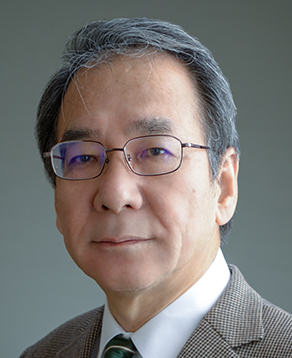
Prof. Masaru Morita
Honorary Prof., Shibaura Institute of Tech.
Specializes in urban hydrology, groundwater hydrology, and flood risk management. Author of "Groundwater Talks - The Crisis of Invisible Resources" (Iwanami Shinsho).
-

Prof. Akihiko Wakai
Professor, Gunma Univ.
Graduate School of Science and Eng.Specializes in disaster prevention, earth and foundationional disasters, etc. Research on computer-based phenomenon prediction, mechanisms for extreme weather/major earthquakes, and disaster mitigation measures.
Past Award Winners
-
9th Grand Prix (Highest Award)
Level 2 Earthquake Dynamic Nonlinear Analysis of Existing Overpass with Composite Piers
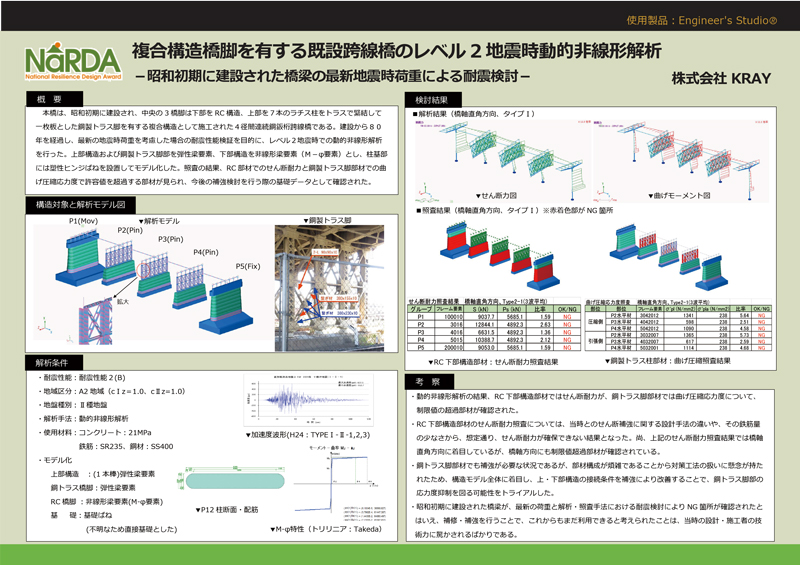 Program Used: Engineer's Studio®
Program Used: Engineer's Studio®
This bridge is a 4-span continuous steel plate girder overpass constructed in the early Showa period. The central three piers are of RC structures in the lower part, and the upper part is a composite structure with steel truss legs consisting of seven lattice columns connected with trusses to form a single plate. It has passed over 80 years since its construction, and a dynamic nonlinear analysis was conducted at the level 2 earthquake to verify the seismic performance of the bridge under the latest seismic loading. The superstructure and steel truss legs were modeled as elastic beam elements, and the substructure as a nonlinear beam element (M-φ element), with plastic hinge springs at the column bases. As a result of the verification, the shear capacity of the RC members and the bending and compressive stress of the steel truss legs exceeded the allowable values, which were confirmed as basic data for future reinforcement studies. -
9th 2nd Prize (Excellence Award)
Preliminary Study of Thermal Cracking Before Construction of New Bridge Abutments
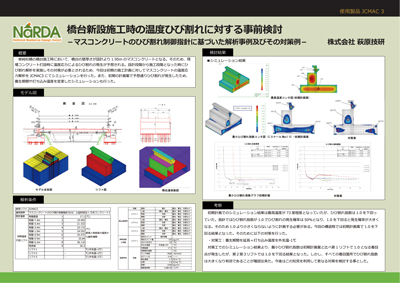 Program Used: JCMAC3
Program Used: JCMAC3
As for the construction of the abutment of a simple girder bridge, the abutment wall was mass concrete of 1.95 m thick according to the design. Therefore, cracking due to thermal stress was expected to occur when the in-situ concrete was placed, and the thermal stress analysis of the mass concrete was conducted with JCMAC3 for the initial construction plan. In addition, cracking occurred as expected in the initial plan, simulations were conducted with different curing periods and pouring temperatures.
-
9th Honorable Judge Award (Prof. Hiromichi Yoshikawa)
Structural Performance Evaluation AwardRe-analysis of Existing Water Distribution Basins and Verification of Reinforced Seismic Performance
-
9th Honorable Judge Award (Prof. Masaru Morita)
Water Supply Resilience AwardWakasuzu Consultants Co., Ltd.
Liquefaction Analysis of Water Pipes
-
9th Honorable Judge Award (Prof. Akihiko Wakai)
Multi-stage Process Analysis AwardImpact Study of Propulsion Pipe Shaft Neighboring Work
-
9th Nomination Award
Dynamic Analysis of Bridges Using Earthquake Motion Predicted by RNN
-
9th Nomination Award
Crack Examination by Temperature Stress Analysis of Caisson Foundation and Countermeasures
-
9th Nomination Award
Ube Industries Consultant Co.,Ltd.
Seismic Performance Verification of Arch Channel Bridge
-
9th Nomination Award
Seismic Performance Verification of a Simple Steel Truss Bridge Built in the 1950s
-
9th Nomination Award
Seismic Performance Verification of River Bridges with Box Structures
Past Award Winners PickUp
-
8th Grand Prix (Highest Award)
Seismic Study of Existing Steel Pipe Arch Water Pipe Bridge
-
7th Grand Prix
Nihon Suiko Consultant Co.,Ltd
Comparison of seismic test result by using 2D and 3D model of existing water tank
-
5th Grand Prix
PENTA-OCEAN CONSTRUCTION CO., LTD.
Residual Strength Evaluation Method using Degradation to check Jetties
-
3rd Grand Prix
Nippon Concrete Industries Co., Ltd.
PC-wall to Retrofit Walls and Analysis During High Seismic Events
-
1st Grand Prix
Tonichi Design Consultant Co., Ltd.
Specifications for Highway Bridges Using 40-year-old Batter Brace Bridge
-
9th NaRDA (2022)
-
- [Grand Prix (Highest Award)]
KRAY Inc.
- Level 2 Earthquake Dynamic Nonlinear Analysis of Existing Overpass with Composite Piers
- 2nd Prize (Excellence Award)
Hagihara Giken Co., Ltd.
- Preliminary Study of Thermal Cracking Before Construction of New Bridge Abutments
- [Honorable Judge Award]
Chikyu Giken Consultant
- Re-analysis of Existing Water Distribution Basins and Verification of Reinforced Seismic Performance
Wakasuzu Consultants Co., Ltd.
- Liquefaction Analysis of Water Pipes
SK Engineering
- Impact Study of Propulsion Pipe Shaft Neighboring Work
- 【Nomination Award】
Knowledge Fusion Co., Ltd.
- Dynamic Analysis of Bridges Using Earthquake Motion Predicted by RNN
Yabu Doken Co., Ltd.
- Crack Examination by Temperature Stress Analysis of Caisson Foundation and Countermeasures
Ube Industries Consultant Co.,Ltd.
- Seismic Performance Verification of Arch Channel Bridge
FUJI Consultants Co.,Ltd.
- Seismic Performance Verification of a Simple Steel Truss Bridge Built in the 1950s
Kitacon Corporation
- Seismic Performance Verification of River Bridges with Box Structures
Sanei Sekkei
- Impact Study of Sewer Facility Neighboring Work
- [Grand Prix (Highest Award)]
-
8th NaRDA (2021)
-
- [Grand Prix (Highest Award)]
NiX Co., Ltd.
- Seismic Study of Existing Steel Pipe Arch Water Pipe Bridge
- [2nd Prize (Excellent Award)]
F-tech Inc.
- United Seismic Performance Verification of Civil Engineering Facility and Architectural Facility
- [Honorable Judge Award]
Knowledge Fusion Co., Ltd.
- Study on Bearing Capacity of RC Beam Members Using Nonlinear Structural Analysis Program
SANKYO ENGINEERING Co., Ltd.
- Level 2 Seismic Performance Verification for Pile-Bent Piers
SEED CONSULTANT,INC.
- Three-Dimensional Dynamic Nonlinear Analysis of a New Five-Span Continuous Steel Pedestrian Deck Bridge
- [Nomination Award]
ORBIT Co.,LTD.
- Level 2 Seismic Study of π-Shaped Rigid-Frame Bridge with PC Diagonal Members
FUJI Consultants Co.,Ltd.
- Single Column Dynamic Analysis by Modeling Pier Frame and Deep Foundation
Kyushu Electric Power Company, Incorporated
- Response Seismic Method of Ground
- [Grand Prix (Highest Award)]
-
7th NaRDA (2020)
-
- [Grand Prix (Highest Award)]
Nihon Suiko Consultant Co.,Ltd
- "Comparison of seismic test result by using 2D and 3D model of existing water tank"
- [2nd Prize (Excellent Award)]
Naigai Engineering Co., Ltd.
- "Seismic performance test using observed seismic motion"
- [Honorable Judge Award]
Sanpoh Co.,LTD
- "Rebar interference check using reverse T-type abutment CIM model"
Civil Engineering and Information Technology Consultants Inc.
- "Flood analysis in urban area"
Geo Formation
- "Influence of construction near railroad"
- [Nomination Award]
Sanei Sekkei
- "3D FEM beam model of a water treatment facility"
Aratani Civil Engineering Consultants CO.,LTD.
- "Seismic measure for continuous girder bridge using existing seismic bearing"
Epoch Design
- "Dynamic Ground Analysis on Tunnel"
- [Grand Prix (Highest Award)]
-
6th NaRDA (2019)
-
- [Grand Prix (Highest Award)]
Akita Prefectural University Faculty of Systems Science and Technology
- "Development of simple measurement technology for steel structures"
- [2nd Prize (Excellent Award)]
F-tech Inc.
- "Flood analysis of rivers in mountain area"
- [Honorable Judge Award]
SHO-BOND CORPORATION Nagoya Branch
- "Validity evaluation of reaction force for bearing design by difference of analysis model"
Knowledge Fusion Co., Ltd.
- "Disaster countermeasures for water supply facilities considering multi-hazards"
Kyushu Civil Engineering
- "Dike ground analysis"
- [Nomination Award]
JR Kyushu Consultants Company
- "JR Kagoshima Main Line track underlay propulsion impact analysis"
Namura Shipbuilding Co., Ltd.
- "Verification of installation method by cable erection method"
Morimatsu Industry Co., Ltd.
- "Proposal of water tank with seismic isolation device for huge earthquakes"
- [Grand Prix (Highest Award)]
-
5th NaRDA (2018)
-
- [Grand Prix (Highest Award)]
Institute of Technology, PENTA-OCEAN CONSTRUCTION CO., LTD.
- "Residual strength evaluation method using degradation level check to jetties"
- [2nd Prize (Excellent Award)]
Knowledge Fusion Co.,Ltd.
- "Seismic performance evaluation according to damage on material"
- [Honorable Judge Award]
KATAHIRA & ENGINEERS INC.
- "Stress analysis on the branch point of steel deck box girder bridge"
Kagoshima University
- "CFD analysis simulation of traditional architecture"
NIHON SAMICON CO., LTD.
- "Seismic performance verification for PC snow shed against L2 earthquake"
- [Nomination Award]
Cosmo Consultants Co., Ltd
- "Seismic verification of coastal embankment"
Marine Support Engineering
- "Seismic performance verification for additional piles against L2 earthquake and tsunami "
APPLIED TECHNOLOGY CO., LTD.
- "Seismic test for a steel intake tower"
Wakasuzu Co., Ltd.
- "Evaluating damage on existing bridge foundation caused by L2 earthquake"
- [Grand Prix (Highest Award)]
-
4th NaRDA (2017)
-
- [Grand Prix (Highest Award)]
Next Energy & Resources Co., Ltd.
- "Design of solar cell support structure"
- [2nd Prize (Excellent Award)]
Nippon Concrete Industries Co., Ltd.
- "Consistency by full scale experiment and nonlinear pushover analysis for PC-wall"
- [Honorable Judge Award]
CIVIC ARTS Consulting Inc.
- "Seismic performance evaluation of eight-continuous water gate"
APPLIED TECHNOLOGY CO., LTD.
- "Seismic performance check of hydraulic steel pipe for power generation"
Japan Association of Diaphragm Wall
- "Strength test analysis by steel diaphragm wall method-II"
- [Nomination Award]
Takenaka Corporation
- "Annual load calculation analysis of exterior"
Ahbo, Inc.
- "Analytical review on cracks in a lid of side ditch"
Wakasuzu Consultants Co., Ltd. Oita office
- "Ground analysis of gas pipe displacement"
- [Grand Prix (Highest Award)]
-
3rd NaRDA (2016)
-
- [Grand Prix (Highest Award)]
Nippon Concrete Industries Co., Ltd.
- "High seismic retrofitting of freestanding retaining wall by using PC-Wall and reasonable performance verification type seismic design method"
- [2nd Prize (Excellent Award)]
Association of road and bridge structure, Ministry of Land, Infrastructure, Transport and Tourism. Central Regional Development Bureau
- "Utilize Engineer's Studio® for personnel training"
- [Honorable Judge Award]
A x C
- "Experimental result about sewerage facilities if applying non-linear FEM analysis, and limit value based on the result"
Oita National College of Technology
- "Shallow water equations based tsunami attack simulation with the idea of disaster prevention on software"
APPLIED TECHNOLOGY CO.,LTD.
- "Verification of tsunami load against shell-type roller gate by using FEM"
- [Nomination Award]
Totetsu Mfg. Co.,Ltd.
- "Structure characteristic understanding of rainwater storage and infiltration facilities "aquapalace method""
Sankyo Technology Co., Ltd.
- "Seismic performance verification and reinforcement analysis of the existing RC ramen pier"
JAPAN-CHINA CONSULTANT Co., LTD Nagoya Office
- "Seismic verification of a water pumping facility"
- [Grand Prix (Highest Award)]
Product Info
FEM Analysis
Engineer's Studio® Dynamic non-linear analysis of 3D laminated plates and cables
FEMLEEG Comprehensive finite element method analysis system
WCOMD Studio
Geotechnical Analysis(GeoFEAS VGFlow / Geo Engineer's Studio / 2D elasto-plastic ground analysis GeoFEAS2D / Dynamic Stress Analysis for Ground UWLC / 3D Slope Stability Analysis LEM3D / 2D seepage analysis (VGFlow)
UC-1 Series
Structural Analysis / Bridge Superstructures / Bridge Substructures / Foundation Work / Temporary Construction / Road/Earth work / Waterworks, etc.
Referral Program
Analysis Support Services


